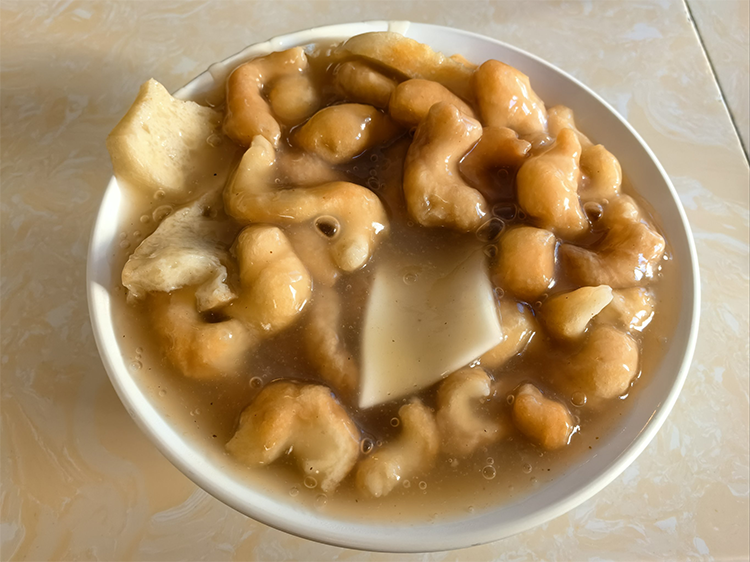Jiayuguan Huguo: Gansu’s Hearty Breakfast Soup
1. Origin and History
Jiayuguan Huguo traces its roots to the Silk Road era when Jiayuguan served as an important frontier pass for merchants and travelers. Locals developed this thick, nourishing breakfast to meet the demands of cold mornings and long journeys. Made from readily available ingredients—chicken, broad beans, and various doughs—Huguo evolved from a simple peasant dish into a street-food staple. Its name, meaning roughly “thick-pot,” refers to the hearty, porridge-like consistency that characterizes the dish.
2. Cultural Significance
More than just food, Huguo is a social ritual in Gansu. Morning street stalls and small family-run shops gather neighbors and early workers for conversation and warmth. The dish symbolizes hospitality and community: sharing a bowl signals welcome and practical kindness on a chilly day. Huguo also reflects broader cultural exchange along the Silk Road, combining local ingredients with influences from Central Asian crops such as broad beans.

3. Key Ingredients
The flavor of Jiayuguan Huguo comes from a careful mix of regional ingredients:
- Chicken broth: simmered long for a deep, savory base.
- Broad bean paste (or flour): creates the dish’s characteristic thickness and yields a gentle bean aroma.
- Shredded chicken and thinly sliced pork or lamb: add protein and texture.
- Bean sheets (fen pi) and wheat gluten: contribute soft, slippery mouthfeel.
- Mahua (fried dough twists): the crunchy garnish that becomes half-soft in the soup for contrast.
- Fresh ginger: a dominant spice that gives Huguo its warming, slightly spicy kick.
These components reflect Gansu’s agricultural resources and cold-climate cooking needs.
4. Preparation Steps
Making an authentic Huguo involves patience and timing:
- Prepare a rich chicken broth by simmering whole chicken pieces with ginger for hours until deeply flavored.
- Mix broad bean powder with water into a smooth slurry. Slowly whisk this into boiling broth so it thickens without lumps.
- Add shredded chicken, thin meat slices, bean sheets, and gluten, simmering until all absorb the broth’s flavor.
- Season with salt and more ginger as needed.
- Just before serving, add broken pieces of fried mahua so part remains crisp while the rest softens.
Traditional vendors cook Huguo in large pots for sharing, but home cooks can reproduce the essentials with simpler equipment.

5. Flavor and Texture
Huguo offers a layered tasting experience. The immediate scent of ginger wakes the palate, while the thick, silky broth—thanks to the broad bean base—coats the mouth. Tender chicken and meat provide satisfying chew, while bean sheets and gluten deliver a soft, elastic texture. The mahua toggles between crisp and tender as it soaks, creating a delightful contrast. Overall, the dish is savory, warmly gingery, and richly comforting without being overly greasy.
6. How to Eat It
Locals enjoy Huguo primarily as a breakfast meal between 6:00 and 10:00 a.m. It’s often eaten with a spoon and sometimes paired with pickled vegetables or steamed buns for balance. For best flavor, stir the bowl so the mahua gets partly soaked and partly crisp. Because the soup is thick, many find it filling enough as a standalone meal. For travelers, trying the local method—eating quickly and chatting with neighbors—adds to the authentic experience.

7. Tasting Recommendations
For the most authentic experience, visit Jiayuguan’s old town or traditional markets at sunrise. Look for busy, family-run stalls—high turnover usually means fresher pots. Try Huguo between 7:00–9:00 a.m. when vendors serve it straight from the pot. In winter, the warming ginger punch is especially welcome; in summer it may feel heavy but remains worth trying. Expect very affordable prices at local stalls, and don’t hesitate to ask for less ginger if you prefer milder spice.
8. Traveler Tips
Practical tips for foreign visitors:
- Pronunciation: say “Huguo” (hoo-gwaw) or show the characters to staff when ordering.
- Communication: point to pictures on menus or use a translation app if needed.
- Hygiene: pick busy stalls with local customers for better turnover and freshness.
- Heat caution: wait a moment to avoid burns—Huguo is served piping hot.
- Experience: pair your meal with a quick visit to Jiayuguan Fortress afterward to connect history with flavor.

9. Simple Home Version
You can try a simplified Huguo at home:
Ingredients: 200g chicken (breast or thigh), 50g broad bean or mung bean powder (or substitute cornstarch), 100g bean sheets, 50g wheat gluten (or tofu), a few mahua or fried dough pieces, ginger, salt, and pepper.
Method: Simmer chicken and ginger for 30 minutes, then shred the chicken. Whisk bean powder into water and add to broth, stirring until thick. Add bean sheets, gluten, and shredded chicken; simmer 5 minutes. Season and serve with mahua on top.
Substitutions: If broad bean powder is unavailable, cornstarch works though the flavor changes. Add less ginger for a milder taste.
10. Conclusion
Jiayuguan Huguo is a delicious doorway into Gansu’s culinary culture—hearty, gingery, and layered in texture. Whether you try it at a bustling street stall in Jiayuguan or make a simplified version at home, this breakfast soup captures the warmth and community spirit of northwest China. Don’t miss a chance to taste Huguo on your next trip—one bowl tells the story of place, history, and hospitality.


